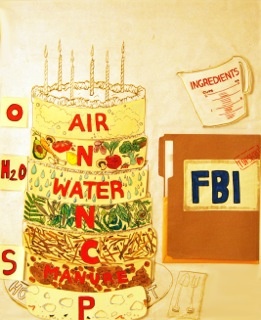Garden Science: CHNOPS

Summary
In this 8th grade science lesson, students review the six essential elements of life and discuss how they function in the garden.
Objectives
After this lesson, students will be able to:
- Name the six essential elements of life
- Recognize the role bacteria in converting non-usable forms of the essential elements into usable compounds that plants can absorb.
Assessments
During this lesson, students will:
- List carbon, hydrogen, nitrogen, oxygen, phosphorus and sulfur as the six elements of life
- Explain that bacteria are responsible for converting non-usable forms of the elements into usable compounds for plants to absorb through their roots.
Materials
- Compost cake visual aid, velcro-backed ingredient cards and file folder (from the Compost Lab)
- Additional Velcro backed element cards (hydrogen, oxygen, phosphorus, sulfur)
- Nitrogen cycle visual aid
- Example cover crop plant (legume) with nitrogen nodes on roots
- The Wind Blows game cards
- The Wind Blows element and bacteria signs
Before You Begin
- Modify the Compost Cake visual aid to include Sulfur and Phosphorus
- Create The Wind Blows game cards
- Plant leguminous plants to show nodules
Procedures
At the Opening Circle
- Introduce the lesson as an extension to the soil pH lesson and review the ideal soil pH.
- Explain that in this lesson, they will focus on the six essential elements of life and learn how bacteria are able to convert them into usable compounds that plants can absorb..
- Explain that living organisms are primarily made up of six elements and that we use the acronym CHNOPS to help us remember what they are.
- Have students repeat each of the six elements: Carbon, Hydrogen, Nitrogen, Oxygen, Phosphorus, and Sulfur.
- Ask students to take in a deep inhale and exhale.
- Ask if any one can identify which of the 6 elements every one just absorbed by inhaling.
- Then ask if any one knows what two elements everyone just exhaled.
- Offer the bonus question: Who can state what organisms “breathe in” CO2? Ask the follow up question: What element do plants and trees then release? (O2)
- Ask students what plants and humans alike absorb through drinking water?
- Explain that oxygen, hydrogen, and even carbon can be easily absorbed by plants and humans, while other nutrients exist mostly in non-usable forms.
- Explain that bacteria are responsible for converting the elements into usable forms for plants to absorb and refer to the compost cake to illustrate where we can find the six elements and bacteria hard at work.
- Explain to students that in their small groups they will also learn about the symbiotic relationship between certain cover crops and bacteria and how this relationship increases the available nitrogen in our soils.
- Review the CHNOPS acronym, and call for choral responses after saying each letter.
- Tell students that in Closing Circle they will play The Wind Blows game, identifying the six essential elements of life and the role of bacteria.
- Divide the class into groups for garden jobs. Encourage students to observe examples of the six essential elements during their time in the garden.
In the Field
- In small working groups visit a bed with cover crop and pull-out a leguminous plant to show students the nitrogen nodules in the root zone.
- Explain nitrogen fixation to students and describe the symbiotic relationship between legumes and bacteria.
- As review, ask students what organisms live in the nodules of legumes and what they do.
At the Closing Circle
Play The Wind Blows, a game similar to musical chairs. To start the game a teacher reads a statement, and all students for whom the statement is true stand up and change seats. The last student standing without a seat reads a follow-up to the statement and then reads the next statement. In this particular instance of the game, the statements are about the six essential elements of life.
Vocabulary
Carbon
Hydrogen
Nitrogen
Oxygen
Phosphorus
Sulfur
Bacteria
Legume cover crop
Nitrogen fixation